How to Do Belt Squat: Muscles Worked, Alternatives and Tips
Author:
Unlock your full potential by engaging with our experts and community! Have questions about your fitness journey or looking for expert advice on weightlifting techniques? Don’t hesitate — leave a comment below and Ihor Shymechko will provide a personalized answer and insights to help you reach your goals.
Torokhtiy is reader-supported. Some links are affiliate links, and we may earn a commission at no extra cost to you. See our disclosure page for details.
The belt squat, or the belted squat, uses the same movement as the regular squat. However, instead of carrying a barbell on your back, you’re pulled down by a weighted belt placed around your hips.
The reason why people do this workout is so they can reduce the stress on their back and eliminate the need for a spotter.In this article, we’ll explain how to do the belt squats and what are the benefits of this exercise. We’ll also share a few belt squat variations you could try out.
The belt squat is a squat variation that uses a weighted belt or a belt squat machine. Unlike the traditional version of exercise, where weights are loaded on your back, this variation eliminates lower back pressure.
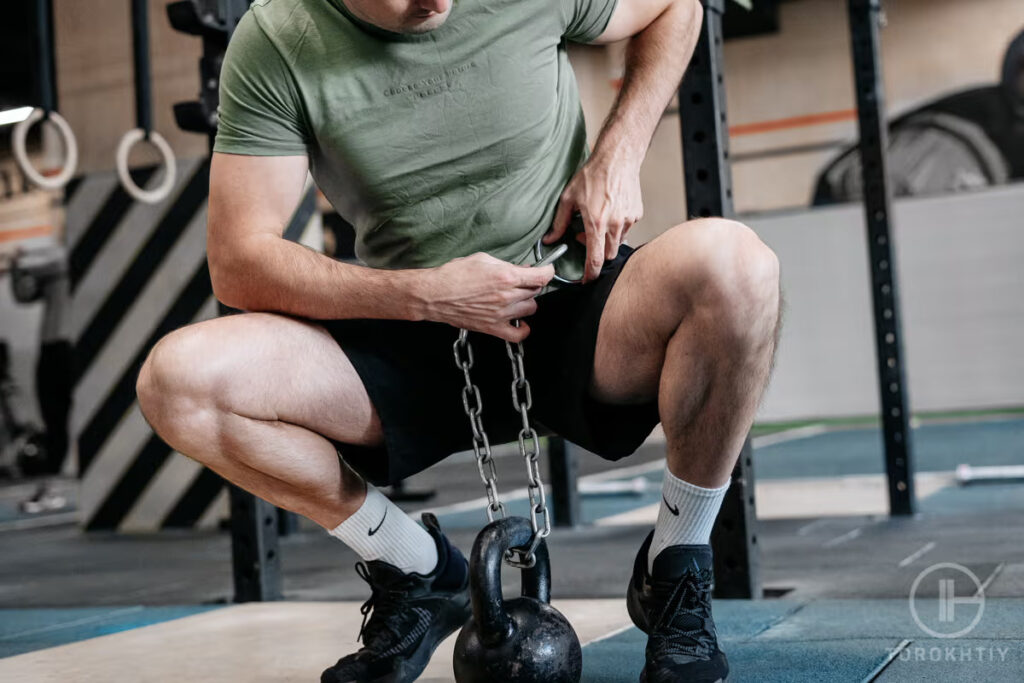
What Is a Belt Squat?
When doing the weighted belt squats, you put all the emphasis on the lower body compared to traditional squats. This training was invented by Louie Simmons in 1975 as a way of making the movement less demanding. Specifically, he had to find a workaround after suffering a major back injury.
Not only are the belt squats more comfortable, but they also don’t require a spotter. Furthermore, this type of workout is popular as it allows you to isolate your lower body. If you use a squat machine, you can spread resistance more evenly, giving you a stable stance during workouts.
Muscles Worked by the Belt Squat Exercise
The main focus of this exercise is on the quadriceps, a large group of muscles used in most sports. The exercise also improves your hamstrings, glutes, adductors, hip flexors, and core muscles. This focus on legs makes the belt squat a perfect workout for all athletes, whether we’re talking about professionals, amateurs, or gym enthusiasts.
If we take a look at the research data, the belt squat has very similar quadriceps activation to the back squat. It also has a similar impact on your hamstrings and adductors. In fact, the main difference in terms of muscle focus is how the belt squats affect your glutes.
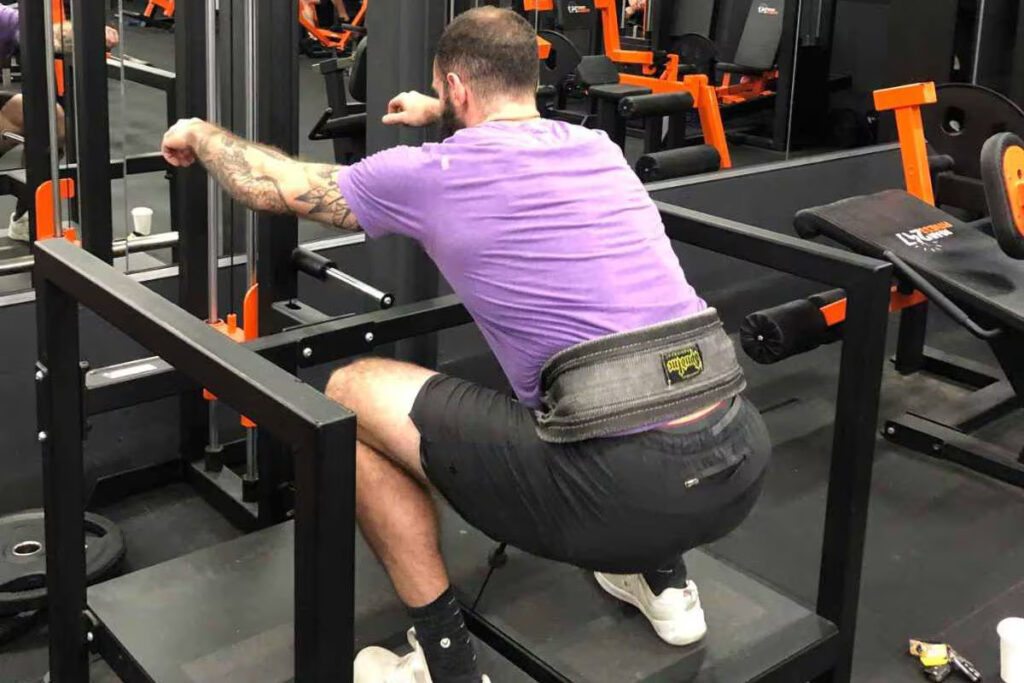
1. Quadriceps
Despite being used by all variations, there are some major differences in how different squats affect the quadriceps. For example, the Spanish squat is supposedly much more effective than the wall squat or the general squat. This is why you need to get your facts straight before implementing any of these exercises in your daily routine.
As previously mentioned, we presume that the belt squat has a similar impact as the traditional squat, but we don’t know how it compares to other variations. Whatever the case, we can still recommend this workout to anyone who is looking to build leg muscles.
Specifically, belt squatting has a massive effect on your quadriceps and less on hip extensors. This makes it an ideal transfer option for RDLs and deadlifts.
2. Hamstrings
During workouts, hamstrings allow you to extend your knees while providing stability to your hips. However, the hamstrings aren’t worked as much as in the traditional squats, given that the traditional version of the exercise requires more posterior muscle activation.
However, that doesn’t mean you won’t work your hamstrings. It’s just that the barbell squatting is much better for this group.
3. Glutes
Glutes help extend the hips, which is crucial for lifting the weight. Although it might seem that having all that weight on your hips forces activation, this isn’t actually the case. In fact, limited data suggest that traditional barbell squats have much more impact on this area. But as with hamstrings, you’ll still work these muscles.
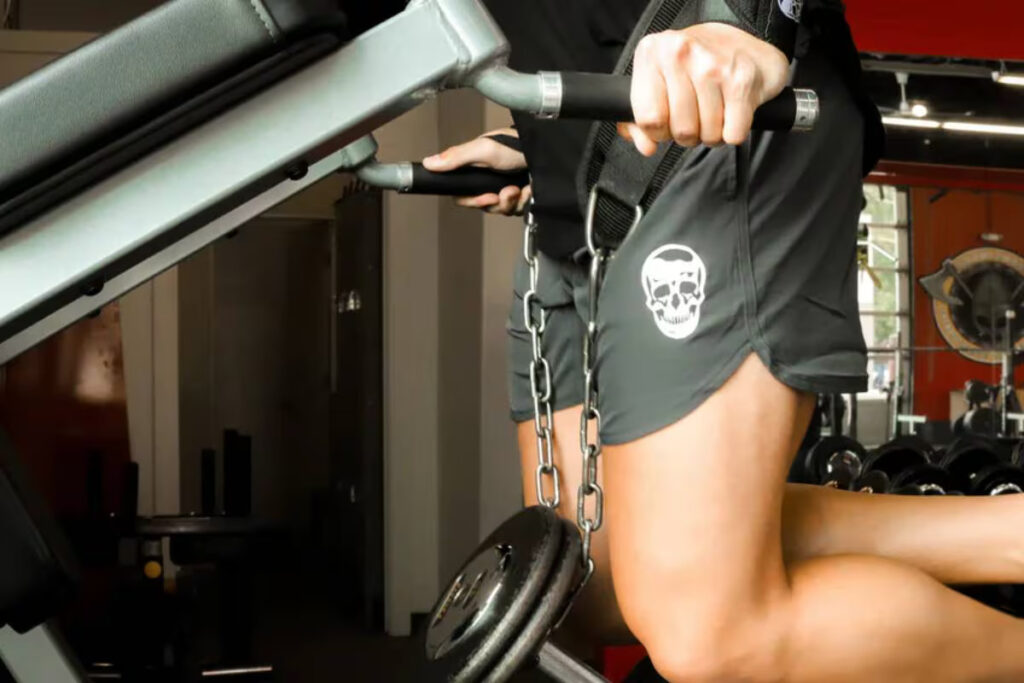
How to Do Belt Squats?
Performing this exercise is fairly straightforward, especially if you have access to a squatting machine (preferable method of doing things). Here’s what you need to do:
1. Basic Setup
To do this exercise, all you need is a regular belt that allows you to load weight directly onto it. If you’re working out without a machine, make sure you’re standing on the elevated stand. That way, the weights won’t hit the ground each time you squat down.
It’s also better to have handles nearby. They will help you pull yourself up when you start working out. Alternatively, you might attach the belt to your hip after standing on the platform.
Your feet should be spread at the length of your shoulders. Furthermore, it’s much better to point your toes outward to avoid hitting them with the plates. Then again, they should also be placed a bit forward to reduce the impact on the hips while maximising quad activation.
2. Execution
If you ever did regular squats, you shouldn’t have a problem with this variation. Here’s a step-by-step guide to performing this exercise:
- To execute a rep, you need to start lowering your body by bending your knees. Make sure you’re inhaling while doing so.
- Like with any other exercise, it’s vital that you slowly lower the weights without sudden movements. The controlled movement is safer and better for your joints but also helps activate your quads.
- Once you’re crouched, push yourself up by focusing on the heels. Ideally, you should once again go with a slower movement so you feel the burn in your thighs. Exhale while going up.
- It’s imperative that you don’t fully extend the knees when you’re in the upward position. Push the hips a bit, take a short break, and repeat the motion.
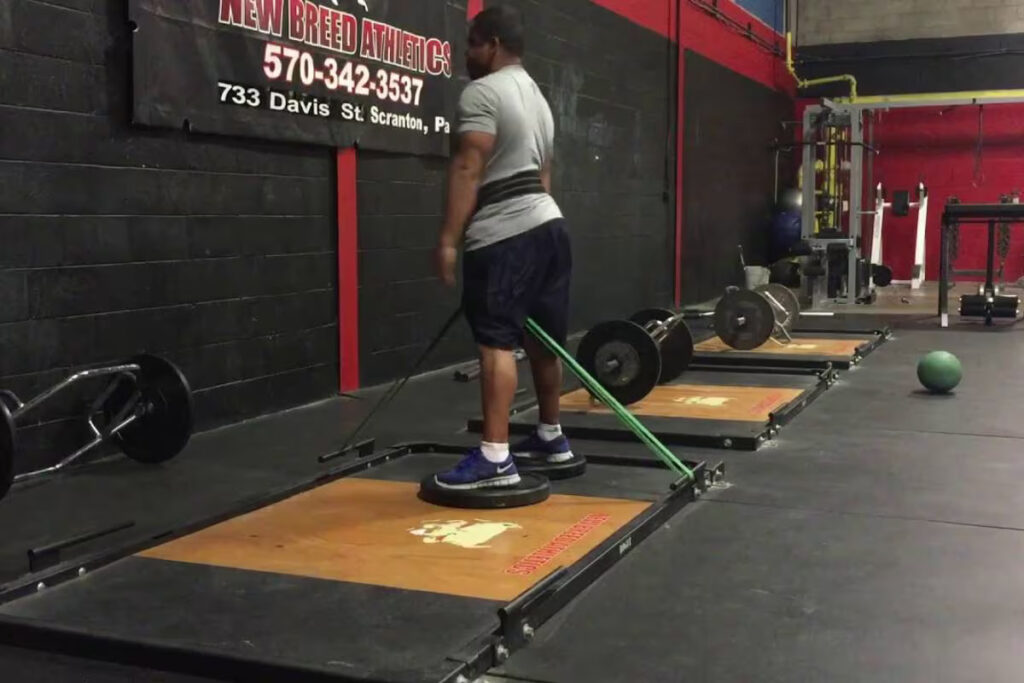
7 Alternatives for Belt Squats
If you’re looking for a belt squat alternative, you should definitely check out some of these workouts:
1. Landmine Belt Squat
The main advantage of landmine belt squats is the fact they’re so challenging. Unlike the belt squat variation, you can heavily load the belt to increase the resistance. Keep in mind you’ll need a landmine attachment to perform this one.
Another good thing about this exercise is that you can modify the effect on quads and glutes. In other words, by facing the landmine, you’ll put more emphasis on the glutes. When you turn away from it, you put focus on your glutes.
2. Sumo Belt Squat
Like with exercise from the sumo category, the thing that differentiates this workout is the stance. Instead of having slightly spread legs, the sumo belt squats require a much wider positioning. So, when using this stance, you’ll have a much shorter range of motion, with significantly shorter and quicker dips.
The main reason why people go with this variation is to change the muscle emphasis. Specifically, the workout puts more focus on your glutes than your quads, which sets it apart from other squat alternatives. Among others, sumo squats don’t require as much forward bending, thus reducing the pressure on your back.
3. Banded Belt Squat
This time around, you’re using bands instead of weights. All you need to do is connect the bands to the basis and the belt, and you’re good to go. This variation is especially great for people who have limited equipment or/and are working out at home.
Furthermore, banded belt squats are a good option for all levels of fitness. However, it’s worth noting this kind of training isn’t as challenging as heavyweight belt squatting.
4. Front Squats
Many people switch to belt squats as a way of reducing stress on the back. Still, that doesn’t mean you have to eliminate the barbell altogether. With front squats, you can use a bar and heavy loading. This time around, all the weight is placed on the front shoulders, which reduces the pressure on your back.
Despite its advantages, the workout has a few drawbacks. Most notably, some people might feel uncomfortable with this kind of loading. Furthermore, front squats can be a bit troublesome if you have a hand injury.
5. Cable Hip Belt Squat
Doing the cable hip belt squats might feel a bit funky at first. This time around, you’re forced to lean backward in a sitting position. As a result, it’s really easy to lose balance when doing this workout. Another troublesome thing is you’ll need an entire cable station to executive the training.
Nevertheless, the cable hip belt squat is fantastic for reducing stress on your back. On top of that, your legs will be constantly under duress, not allowing you to take a break for even a moment.
6. Goblet Squat
In a way, the goblet squats are a variation of the front squats. For this particular exercise, you’ll need a kettlebell or dumbbell, which you should hold on your wrists like a massive goblet. The main advantage of the goblet squat compared to front squats is that there’s much less pressure on your hands.
This squat variation is easy to set up and doesn’t require any particular equipment. The only issue is that you can’t load as much weight as you could with the traditional or the front squats.
7. Safety Bar Squat
As you could guess by the name, this variation is much safer than the traditional squat. Basically, you’ll have a safety barbell placed on your shoulders, which eliminates the need for a spotter. Furthermore, there’s also extra padding on the bar that makes it that much more comfortable.
Unfortunately, despite being safer than the traditional back-loaded squat, this exercise still has its drawback. To be specific, like regular squatting, it puts lots of pressure on your lower back.
How to Use Belt Squat Machine?
Unlike the usual belt squats, where the plates are dangling from your belt, the squat machine attaches the belt to cables. These cables are sticking out of the stand and are connected to the machine. Otherwise, executing the workout is basically the same as the machineless belt squats.
In both cases, the impact of forces is very similar, continuously pulling your body and hips downward. Using the machine for your belt squats feels much more comfortable, as you don’t have to worry about the plates swinging left and right.
An interesting thing about belt squatting machines is that each one of them can have a different impact on your body.
Weighted Dip Belt We Recommend
No matter what kind of belt squatting you want to do, you’ll need a reliable belt. That being said, we’d like to recommend Dip Belt With Chain for Weightlifting by DMoose.
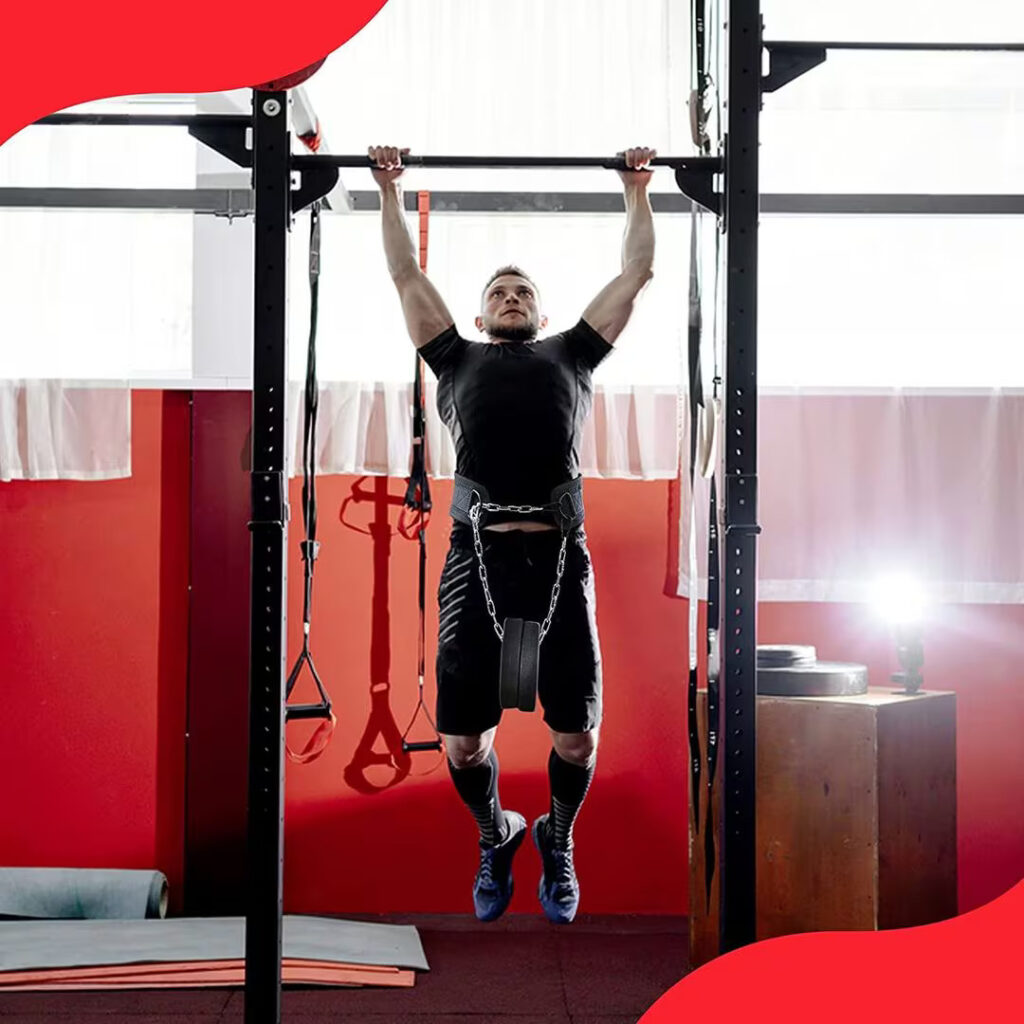
The product is made from resilient materials and will last for quite a while. The company provides free delivery and you also have a 30-day money-back guarantee. Another cool thing is that you can choose between several designs, each better than the last.
FAQ
Are Belt Squats Good for Knees?
Like all other squat variations, the belt squats can help build leg muscles, which can be beneficial if you have weak knees.
Can You Perform Belt Squats Without a Belt Squat Machine?
Although using a belt squat machine feels great, you can easily execute this training without expensive equipment.
All you need is a squatting belt with a chain and some plates. Stand on elevated ground, and attach the weights to the belt. Make sure that the chain is long enough so that the plates don’t touch the ground. Then, slightly spread your legs and start squatting.
What Muscles Are Involved in Belt Squat Exercise?
The belt squats mainly focus on lower body muscles. During workouts, you’ll develop quads, glutes, hamstrings, hip flexors, adductors, and core muscles. Out of all these muscle groups, the biggest emphasis is on the quadriceps.
Conclusion
The belt squat is an amazing choice if you wish to do squats but don’t want to load all this weight on your back. Athletes can do this type of training by using a squat machine or by simply attaching plates to a belt.
Like regular squats, this type of workout is fantastic for your legs, helping improve the strength of your hamstrings, quads, and glutes. As such, it can be a great addition to your routine, whether you’re a professional or amateur.
How often do you perform belt squats? Do you use a machine? Tell us more in the comments below!
Also read:
- Glute Ham Machine Exercises
- Roman Chair Workouts
- Ultimate Ab Machine Guide
- Seated Calf Raise
- Seated vs Standing Calf Raise
- Beginner’s Guide To Cable Machines
- What Does A Weightlifting Belt Do
References:
- The back squat: A proposed assessment of functional deficits and technical factors that limit performance // Ncbi: https://www.ncbi.nlm.nih.gov/pmc/articles/PMC4262933/
- Comparison of Muscle Activation Between Back Squats and Belt Squats // Pubmed: https://pubmed.ncbi.nlm.nih.gov/28595237/
- Differences in the muscle activities of the quadriceps femoris and hamstrings while performing various squat exercises // Pubmed: https://pubmed.ncbi.nlm.nih.gov/35063016/
- The Effect of Stance Width on the Electromyographical Activity of Eight Superficial Thigh Muscles During Back Squat With Different Bar Loads // Journals: https://journals.lww.com/nsca-jscr/FullText/2009/01000/The_Effect_of_Stance_Width_on_the.36.aspx
- Comparison of muscle activation of 3 diff erent hip belt squat techniques // Rehabilityjournal: https://www.rehabilityjournal.com/articles/jnpr-aid1035.pdf
- Comparison of muscle activation of 3 diff erent hip belt squat techniques // Setforset: https://www.setforset.com/blogs/news/belt-squats
Why Trust Us?
With over 20 years in Olympic weightlifting, strength training, nutrition coaching, and general fitness our team does its best to provide the audience with ultimate support and meet the needs and requirements of advanced athletes and professional lifters, as well as people who strive to open new opportunities and develop their physical capabilities with us.
By trusting the recommendations of our certified experts in coaching, nutrition, and sports training programming, as well as scientific consultants, and physiotherapists, we provide you with thorough, well-considered, and scientifically proven content. All the information given in the articles concerning workout programming, separate exercises, and athletic performance, in general, is based on verified data.
The product testing process is described in more detail here.
Author: Ihor Shymechko
Pro Olympic Weightlifter, Coach
Best Results: Snatch – 208 kg,
C&J – 240 kg
Ihor has been a professional weightlifter since 1996, boasting over two decades of competition experience. His notable achievements include clinching the European Championship in 2009 and securing a silver medal in the 105kg division at the Senior World Championships in 2011. Ihor represented his country in the 2008, 2012, and 2016 Summer Olympics. After retiring from competitive weightlifting, he transitioned to coaching, leveraging his vast experience to guide athletes who now compete on both national and international stages.



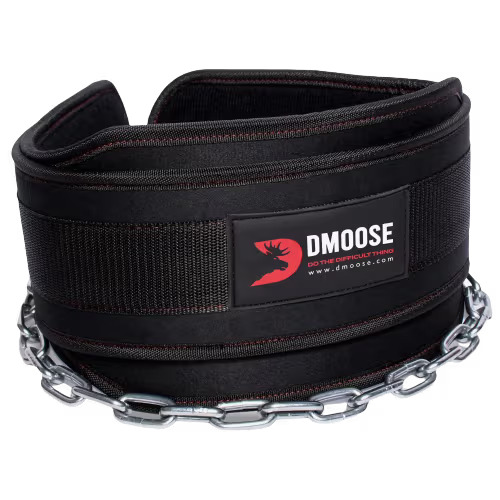
Still have questions after reading our article? Unlock your full potential by engaging with our experts and community! Don’t hesitate — leave a comment below and Ihor Shymechko will provide a personalized answer and insights to help you reach your goals.